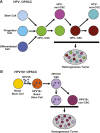Are all cancer stem cells created equal?
- PMID: 25122687
- PMCID: PMC4181401
- DOI: 10.5966/sctm.2014-0085
Are all cancer stem cells created equal?
Abstract
Numerous solid malignancies have been reported to contain cancer stem cells (CSCs). Distinct functional characteristics have been attributed to CSCs, and thus it is widely believed that these unique cells may have genetic and phenotypic homogeneity. Recent exciting but limited evidence, however, contradicts this tenet and supports the intriguing concept of genetic and phenotypic diversity in the CSC population. We propose that CSC heterogeneity at the inter- and intrapatient levels may be due to the cell of origin, to environmental cues, and/or to human papillomavirus infection. Additional insight into CSC heterogeneity is needed to identify actionable targets for optimal eradication of the diverse CSC subpopulations within a tumor.
©AlphaMed Press.
Figures


References
-
- Schwitalla S, Fingerle AA, Cammareri P, et al. Intestinal tumorigenesis initiated by dedifferentiation and acquisition of stem-cell-like properties. Cell. 2013;152:25–38. - PubMed
-
- Vermeulen L, De Sousa EMF, van der Heijden M, et al. Wnt activity defines colon cancer stem cells and is regulated by the microenvironment. Nat Cell Biol. 2010;12:468–476. - PubMed
-
- Biddle A, Liang X, Gammon L, et al. Cancer stem cells in squamous cell carcinoma switch between two distinct phenotypes that are preferentially migratory or proliferative. Cancer Res. 2011;71:5317–5326. - PubMed
Publication types
MeSH terms
Grants and funding
LinkOut - more resources
Full Text Sources
Other Literature Sources

